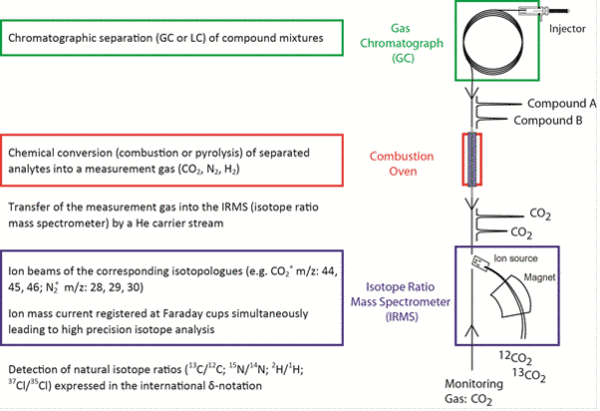Welcome to the Isotopes and Environmental Chemistry Group
Head: Prof. Dr. Martin Elsner
We advance compound-specific isotope analysis for the measurement of isotope ratios inside organic compounds at their natural isotopic abundance. Our goal is to track compounds from different sources, to detect natural transformation of organic compounds and to pinpoint chemical transformation mechanisms in environmental and technical systems. Through analytical innovation we aim to contribute to a better management of chemicals in the environment, to characterizing natural attenuation and to optimizing turnover in technical systems.
Compound-Specific Isotope Analysis using Gas Chromatography-Isotope Ratio Mass Spectrometry (GC-IRMS) and Liquid Chromatography-Isotope Ratio Mass Spectrometry (LC-IRMS)
To implement the research aims of our group, Compound-Specific Isotope Analysis (CSIA) is used as an analytical tool to receive information on natural isotope abundances of 13C/12C, 15N/14N, 2H/1H, 37Cl/35Cl. CSIA is accomplished by the hyphenation of either a gas chromatograph (GC) or a liquid chromatograph (LC) with an isotope ratio mass spectrometer (IRMS) according to the following principle:
Principle:

Application
- Development of new analytical methods for pesticides, pharmaceuticals and chlorinated compounds (see publications below) for analyses of isotope compositions in degradation experiments and field samples
- Development of chlorinated reference materials for Cl and C isotope analysis
-
Routine isotope analyses of organic contaminants (aromatic hydrocarbons, chlorinated hydrocarbons) in cooperation with our spin-up company Isodetect GmbH
Bulk Isotope Analysis by Elemental Analyzer (EA)-IRMS and Dual-Inlet-IRMS
- Chemical conversion (online or offline combustion or pyrolysis) into a measurement gas (CO2, N2, H2, SO2, CO)
- Determination of natural isotope ratios (13C/12C; 15N/ 14N; 2H/1H, 18O/16O, 34S/32S) of nitrate, nitrite, sulfate, sulfite, sulfide, water, organic compounds
- Participation in international proficiency (ring-tests) tests
- Standardization of internal laboratory-reference materials
Publications
- E. O. Mogusu, B.J. Wolbert, D. M. Kujawinski, M. A. Jochmann, M. Elsner, Dual element (15N/14N, 13C/12C) isotope analysis of glyphosate and AMPA by derivatization-gas chromatography isotope ratio mass spectrometry (GC/IRMS) combined with LC/IRMS; Analytical and bioanalytical chemistry (2015): 1-12.
- M. P. Maier, S. Qiu, M. Elsner, Enantioselective stable isotope analysis (ESIA) of polar herbicides; Analytical and Bioanalytical Chemistry, (2013), 405, (9), 2825-2831.
- K. Schreglmann, M. Hoeche, S. Steinbeiss, S. Reinnicke, M. Elsner, Carbon and Nitrogen Isotope Analysis of Atrazine and dethylatrazine at Sub-µg/L Concentrations in Groundwater; Analytical and Bioanalytical Chemistry, (2013) DOI 10.1007/s00216-012-6616-0
- S. Spahr, S. Huntscha, J. Bolotin, M. P. Maier, M. Elsner, J. Hollender, T. B. Hofstetter, Compound-specic isotope analysis of benzotriazole and its derivatives; Analytical and Bioanalytical Chemistry (2013) DOI 10.1007/s00216-012-6526-1
- M. Elsner, M. A. Jochmann, T. B. Hofstetter, D. Hunkeler, A. Bernstein, T. C. Schmidt, A. Schimmelmann, Current challenges in compound-specific stable isotope analysis of environmental organic contaminants, Analytical and Bioanalytical Chemistry, 403 (2012), 2471–2491.
- S. Reinnicke, D. Juchelka, S. Steinbeiss, A. Meyer, A. Hilkert, M. Elsner, Gas chromatography-isotope ratio mass spectrometry (GC-IRMS) of recalcitrant target compounds: performance of different combustion reactors and strategies for standardization, Rapid Communications in Mass Spectrometry, 26 (2012), 1053–1060.
- A. Bernstein, O. Shouakar-Stash, K. Ebert, C. Laskov, D. Hunkeler, S. Jeannottat, K. Sakaguchi-Söder, J. Laaks, M. A. Jochmann, S. Cretnik, J. Jager, S. B. Haderlein, T. C. Schmidt, R. Aravena, M. Elsner, Compound-Specific Chlorine Isotope Analysis: A Comparison of Gas Chromatography/Isotope Ratio Mass Spectrometry and Gas Chromatography/Quadrupole Mass Spectrometry Methods in an Interlaboratory Study, Analytical Chemistry, 83 (2011), 7624–7634.
- M. Elsner, Stable Isotope Fractionation to Investigate Natural Transformation Mechanisms of Organic Contaminants: Principles, Prospects and Limitations, Journal of Environmental Monitoring, 12 (2010), 2005-2031
- S. Reinnicke, A. Bernstein, M. Elsner, Small and Reproducible Isotope Effects during Methylation with Trimethylsulfonium Hydroxide (TMSH): A Convenient Derivatization Method for Isotope Analysis of Negatively Charged Molecules, Analytical Chemistry, 82 (2010), 2013-2019.
- A.H. Meyer, H. Penning, H. Lowag, M. Elsner, Precise and Accurate Compound Specific Carbon and Nitrogen Isotope Analysis of Atrazine: Critical Role of Combustion Oven Conditions, Environmental Science & Technology, 42 (2008), 7757-776
- H. Penning and M. Elsner, Intramolecular Carbon and Nitrogen Isotope Analysis by Quantitative Dry Fragmentation of the Phenylurea Herbicide Isoproturon in a Combined Injector/Capillary Reactor prior to GC Separation, Analytical Chemistry, 79 (2007), 8399-8405



